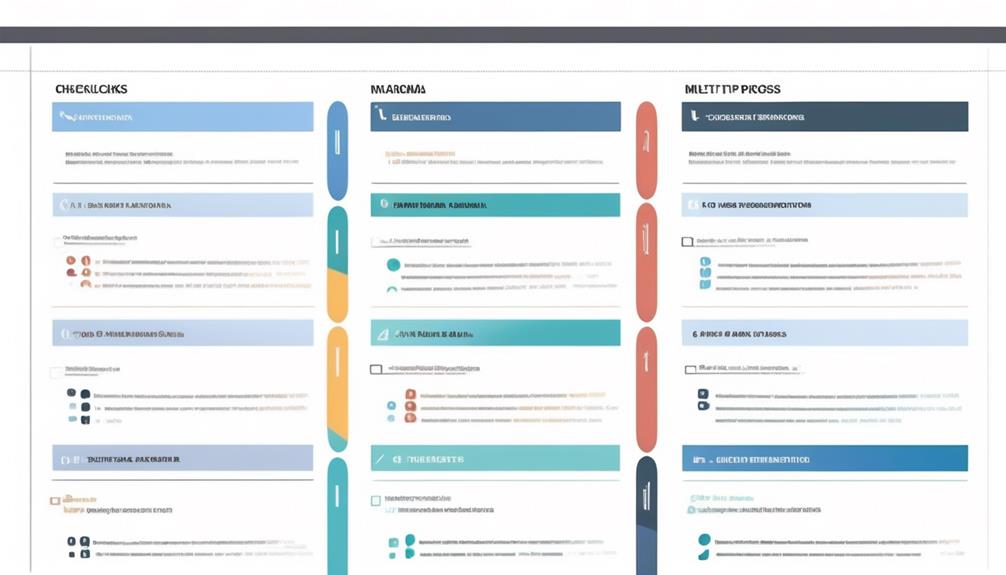Many experts agree that implementing Six Sigma methodologies can lead to significant improvements in process efficiency, with potential enhancements of 50 to 90%. The main question that arises is: how can we achieve such impressive results?
Well, the answer lies in five key tips that can make a substantial difference in boosting quality with Six Sigma. These tips are not just theoretical concepts but practical strategies that have been proven to yield tangible results in various industries.
So, what are these tips and how can they be effectively applied to drive quality improvements? Stay tuned as we unravel the secrets to leveraging Six Sigma for enhanced quality and performance.
Key Takeaways
- Lean Six Sigma principles streamline processes and enhance customer satisfaction.
- Implementing Lean Six Sigma leads to reduced process variation and improved performance.
- Process improvement techniques such as 5S, Kanban, Standardized Work, and Value Stream Mapping can facilitate effective process improvements.
- Lean Six Sigma principles result in improved performance, customer satisfaction, waste reduction, and operational efficiency.
Understanding Lean Six Sigma Principles
We regularly utilize Lean Six Sigma principles to streamline processes and eliminate inefficiencies within our organization. Understanding these principles is crucial for achieving process improvement and enhancing customer satisfaction.
Lean Six Sigma, a combination of Lean and Six Sigma methodologies, provides a systematic approach to reducing defective goods, minimizing process variation, and improving performance.
The DMAIC (Define, Measure, Analyze, Improve, Control) framework is at the core of Lean Six Sigma, guiding our efforts to identify problems, measure existing processes, analyze data to find root causes, implement solutions, and establish controls to sustain improvements.
Implementing 5S Methodology for Improvement

Implementing the 5S methodology for improvement involves strategically organizing and maintaining the workspace to enhance efficiency and safety. The 5S approach, which stands for Sort, Set in order, Shine, Standardize, and Sustain, is a foundational aspect of Lean Six Sigma.
By implementing 5S, organizations can streamline their processes, reduce waste, and create a safer work environment. This methodology not only helps in maximizing efficiency but also significantly contributes to improving workplace safety by eliminating potential hazards and promoting a clean and organized workspace.
Many successful organizations, such as Starbucks, have effectively utilized 5S to drive process improvements and enhance overall quality.
To implement 5S effectively, it’s essential to involve the entire team in the process. This may include providing training on 5S principles and involving employees in 5S projects.
Additionally, Value Stream Mapping can be utilized to identify areas for improvement and guide the implementation of 5S. By systematically addressing the defect rate and creating standardized processes, organizations can achieve sustainable improvements in quality and productivity.
Applying Kanban for Process Enhancement
Using visual signals through Kanban triggers actions and improves process flow, enhancing overall efficiency and customer satisfaction. Implementing Kanban can significantly improve process transparency, communication, and ultimately customer satisfaction.
Here are five key ways Kanban can enhance process efficiency and customer satisfaction:
- Utilize Kanban in simple ways such as email auto-responders or package tracking to enhance process efficiency.
- Improve customer satisfaction by implementing Kanban for clear communication and efficient process management.
- Enhance process transparency and communication about next steps by using Kanban methods.
- Implementing Kanban can result in happier and more loyal customers by streamlining processes and reducing delays.
- Kanban can be effectively used within a Lean Six Sigma Green Belt Training framework to address process problems, improve customer satisfaction, and drive continuous improvement.
Utilizing Standardized Work for Scalability

Utilizing standardized work is essential for achieving scalability and consistency in processes, ensuring that operations can be efficiently replicated and maintained across different teams or locations. By standardizing work processes, organizations can eliminate variations, reduce errors, and increase efficiency. This is particularly crucial in the context of Six Sigma, a methodology focused on improving quality by identifying and removing the causes of defects and minimizing variability in business processes.
In the table below, we outline the key benefits of utilizing standardized work for scalability and efficiency, as well as how it aligns with the principles of LEAN, a systematic method for waste minimization within a manufacturing system without sacrificing productivity.
| Benefits of Standardized Work | Alignment with LEAN Principles |
|---|---|
| Consistency in processes | Elimination of waste |
| Replicability across teams | Standardization |
| Error reduction | Process improvement |
| Scalability | Efficiency |
| Quality assurance | Waste reduction |
Standardized work not only addresses process problems but also fosters a culture of continuous improvement. It provides a solid foundation for organizations to build upon, ensuring that as they grow, quality and efficiency remain paramount.
Creating Value Stream Mapping for Waste Elimination
In our pursuit of operational excellence, the pivot from standardizing work processes to creating value stream mapping for waste elimination allows us to further enhance efficiency and identify opportunities for continuous improvement. Value stream mapping, a key tool in Six Sigma and Lean methodologies, plays a vital role in the quest for quality.
Here are five key points to consider:
- Value stream mapping helps eliminate waste and calculate lead time, providing a clear understanding of the current state of processes.
- It provides a visual flowchart of steps, delays, and necessary information, enabling teams to identify bottlenecks and areas for improvement.
- By optimizing workflow and improving processes, value stream mapping facilitates the elimination of non-value-added activities, enhancing overall operational efficiency.
- It helps in identifying areas that don’t add value, enabling a targeted approach to waste elimination and process improvement.
- Creating a value stream map can be done in about an hour and helps in streamlining processes, making it a time-efficient yet effective tool for continuous improvement initiatives.
The incorporation of value stream mapping into our measurement system empowers Green and Black Belts to identify and address waste, contributing to the overall success of DMAIC projects and the organization’s commitment to quality.
Employing the 5 Whys for Root Cause Analysis

We will now explore the effectiveness of employing the 5 Whys technique for root cause analysis.
This technique involves asking ‘why’ repeatedly to uncover the underlying reasons behind a problem.
Why 5 Whys Works
The 5 Whys method is a powerful and straightforward tool for uncovering the root causes of problems by iteratively probing for deeper layers of causation. This method works effectively in the Six Sigma framework, as it delves into the causes of process problems during the Analyze phase.
Here’s why the 5 Whys works:
- It provides a structured approach to problem-solving.
- It encourages a data-driven analysis of issues.
- It aids in identifying the fundamental causes of quality issues.
- It aligns with the goal of improving quality for customers.
- It complements other tools used in the Six Sigma methodology to address process problems in a systematic manner.
Root Cause Analysis Benefits
Employing the 5 Whys method for root cause analysis brings about significant benefits in uncovering underlying issues within processes and facilitating more effective and sustainable process improvements. The 5 Whys technique allows for a systematic approach to identifying the root cause of process problems, leading to data-driven solutions that improve efficiency and reduce waste. By delving into the underlying reasons behind a problem, organizations can prevent its reoccurrence, thereby enhancing customer satisfaction. The method also aligns with Six Sigma principles, empowering Green Belts and Black Belts to implement a robust monitoring plan. This leads to a more proactive and preventive approach, ensuring that process improvements are sustained over time. The table below illustrates the benefits of employing the 5 Whys for root cause analysis.
| Root Cause Analysis Benefits | ||
|---|---|---|
| Uncover underlying issues | Facilitate effective process improvements | Prevent problem reoccurrence |
Achieving Quick Wins for Improved ROI

Identifying and prioritizing low-hanging fruit processes is essential for achieving quick wins and maximizing return on investment in quality improvement initiatives. When it comes to implementing Six Sigma methodology, focusing on quick wins can significantly impact the bottom line. To achieve quick wins for improved ROI, consider the following:
- Leverage Data-Driven Insights: Utilize data collection and analysis to identify areas with the potential for rapid improvement, enabling targeted and effective changes.
- Prioritize High-Impact Areas: Concentrate on high-impact processes that can yield substantial cost savings or efficiency gains.
- Implement Small-Scale Changes: Introduce incremental adjustments to processes, allowing for immediate benefits without disrupting the entire workflow.
- Focus on Short Turnaround Projects: Prioritize projects with short turnaround times, allowing for rapid ROI and quick wins that demonstrate the effectiveness of Six Sigma principles.
- Utilize LEAN and Six Sigma Principles: Incorporate LEAN methodologies alongside Six Sigma to streamline processes and drive quick, impactful improvements.
Frequently Asked Questions
What Are the 5 Key Principles of Six Sigma?
The five key principles of Six Sigma are defined as:
- Customer focus: This principle emphasizes the importance of understanding and meeting customer needs. By putting the customer at the center of our decision-making processes, we can ensure that we are delivering products and services that truly satisfy their requirements.
- Data-driven decision making: This principle highlights the use of data to drive our decision-making processes. By collecting and analyzing relevant data, we can make informed decisions that are based on facts rather than assumptions or intuition.
- Process improvement: This principle focuses on continually improving our processes. By identifying and eliminating waste, reducing variation, and streamlining our operations, we can enhance efficiency and effectiveness, leading to better outcomes for our customers and our organization.
- Proactive management: This principle emphasizes the need for proactive management. By anticipating and addressing potential issues before they become problems, we can prevent defects, errors, and other quality issues from occurring in the first place.
- Pursuit of perfection: This principle encourages us to constantly strive for excellence in everything we do. By setting high standards and continuously pushing ourselves to achieve them, we can create a culture of excellence that drives us toward continuous improvement and innovation.
These principles form the foundation of our Six Sigma methodology. By adhering to them, we can ensure that quality and efficiency are at the forefront of our operations, enabling us to deliver products and services that meet or exceed customer expectations.
What Are the Five Steps That Are Required to Improve Quality Using Six Sigma?
We identify process problems, measure key aspects, analyze data, improve processes, and control for errors.
For instance, in a manufacturing setting, we used Six Sigma to reduce defects in a production line.
First, we pinpointed where defects were occurring, then we measured the defect rate, analyzed the root causes, implemented process improvements, and established controls to prevent future defects.
These steps helped us significantly enhance product quality.
What Are the 5 Steps of Sigma?
The 5 steps of Six Sigma are:
Define, Measure, Analyze, Improve, and Control.
These steps are crucial in improving quality and efficiency.
We start by defining the problem and aligning goals,
then measure the current process performance to identify areas of improvement.
Next, we analyze the data to isolate the reasons for failure.
After that, we develop improvement plans and test solutions.
What Are the Factors Enhancing Quality in Six Sigma?
Factors enhancing quality in Six Sigma include:
- Data-driven decision-making
- Process standardization
- A continuous improvement culture
- Effective communication and feedback
- Value-adding Lean Six Sigma tools
These elements ensure:
- Informed decision-making
- Minimization of errors
- Promotion of a culture of improvement
- Facilitation of effective communication
- Utilization of appropriate tools for better results
Overall, they contribute to achieving:
- Consistent quality
- Efficiency within the Six Sigma framework.
Conclusion
In conclusion, by incorporating Lean Six Sigma principles and methodologies such as 5S, Kanban, standardized work, value stream mapping, and the 5 Whys, we can drive significant improvements in quality and efficiency.
These tools provide us with the means to identify and eliminate waste, streamline processes, and achieve quick wins that lead to a substantial return on investment.
By embracing these techniques, we can continuously enhance our operations and deliver exceptional value to our customers.









